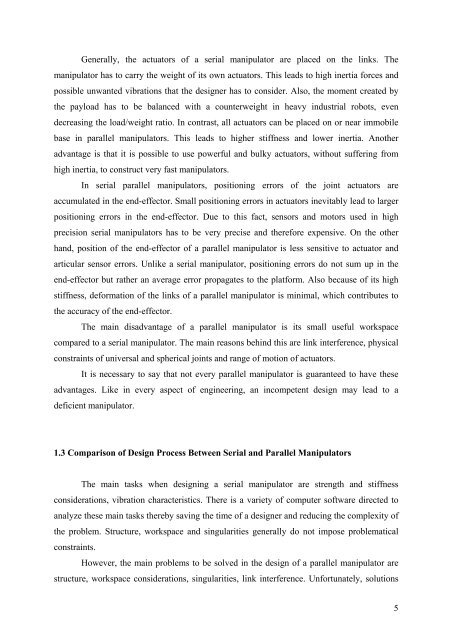Kinematic and Dynamic Analysis of Spatial Six Degree of Freedom ...
Kinematic and Dynamic Analysis of Spatial Six Degree of Freedom ...
Kinematic and Dynamic Analysis of Spatial Six Degree of Freedom ...
You also want an ePaper? Increase the reach of your titles
YUMPU automatically turns print PDFs into web optimized ePapers that Google loves.
Generally, the actuators <strong>of</strong> a serial manipulator are placed on the links. The<br />
manipulator has to carry the weight <strong>of</strong> its own actuators. This leads to high inertia forces <strong>and</strong><br />
possible unwanted vibrations that the designer has to consider. Also, the moment created by<br />
the payload has to be balanced with a counterweight in heavy industrial robots, even<br />
decreasing the load/weight ratio. In contrast, all actuators can be placed on or near immobile<br />
base in parallel manipulators. This leads to higher stiffness <strong>and</strong> lower inertia. Another<br />
advantage is that it is possible to use powerful <strong>and</strong> bulky actuators, without suffering from<br />
high inertia, to construct very fast manipulators.<br />
In serial parallel manipulators, positioning errors <strong>of</strong> the joint actuators are<br />
accumulated in the end-effector. Small positioning errors in actuators inevitably lead to larger<br />
positioning errors in the end-effector. Due to this fact, sensors <strong>and</strong> motors used in high<br />
precision serial manipulators has to be very precise <strong>and</strong> therefore expensive. On the other<br />
h<strong>and</strong>, position <strong>of</strong> the end-effector <strong>of</strong> a parallel manipulator is less sensitive to actuator <strong>and</strong><br />
articular sensor errors. Unlike a serial manipulator, positioning errors do not sum up in the<br />
end-effector but rather an average error propagates to the platform. Also because <strong>of</strong> its high<br />
stiffness, deformation <strong>of</strong> the links <strong>of</strong> a parallel manipulator is minimal, which contributes to<br />
the accuracy <strong>of</strong> the end-effector.<br />
The main disadvantage <strong>of</strong> a parallel manipulator is its small useful workspace<br />
compared to a serial manipulator. The main reasons behind this are link interference, physical<br />
constraints <strong>of</strong> universal <strong>and</strong> spherical joints <strong>and</strong> range <strong>of</strong> motion <strong>of</strong> actuators.<br />
It is necessary to say that not every parallel manipulator is guaranteed to have these<br />
advantages. Like in every aspect <strong>of</strong> engineering, an incompetent design may lead to a<br />
deficient manipulator.<br />
1.3 Comparison <strong>of</strong> Design Process Between Serial <strong>and</strong> Parallel Manipulators<br />
The main tasks when designing a serial manipulator are strength <strong>and</strong> stiffness<br />
considerations, vibration characteristics. There is a variety <strong>of</strong> computer s<strong>of</strong>tware directed to<br />
analyze these main tasks thereby saving the time <strong>of</strong> a designer <strong>and</strong> reducing the complexity <strong>of</strong><br />
the problem. Structure, workspace <strong>and</strong> singularities generally do not impose problematical<br />
constraints.<br />
However, the main problems to be solved in the design <strong>of</strong> a parallel manipulator are<br />
structure, workspace considerations, singularities, link interference. Unfortunately, solutions<br />
5
















